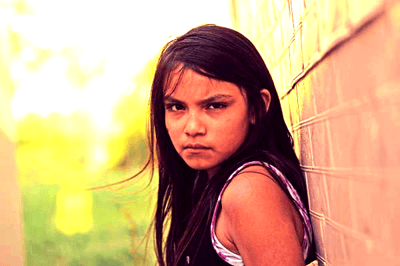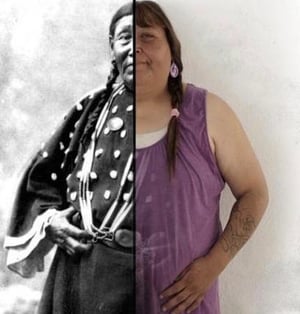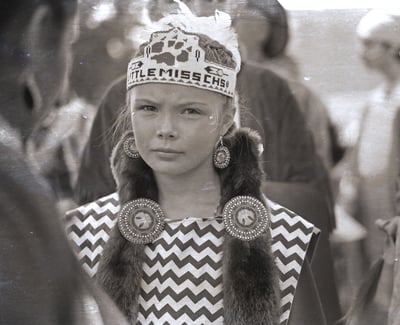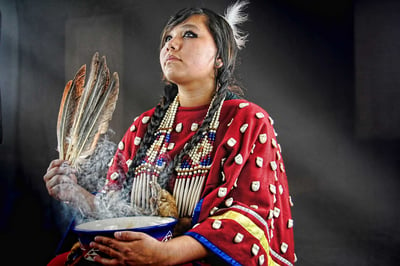“I knew growing up that at some point I was supposed to be the things I learned in the stories: compassionate, honorable, and brave, and so forth. I knew this because the storytellers lived the lessons they imparted in their stories, and practiced what they preached: they were compassionate, they were honorable, and they were brave and wise.” - Joseph Marshall
This page explores how trauma passes down from generation to generation, why it is so difficult to break free from destructive family patterns, and how people can embrace their stories in order to find healing.
For many people, there is a challenging gap between the person they are and the person they want to be or feel called to be.
This tension is most obvious in people and communities with self-destructive habits. On one hand, there is a genuine desire for change, responsibility, and improvement. On the other hand, there are patterns of relating, thinking, and behaving that seem nearly impossible to break. There are also major social and cultural barriers to overcome.
It’s no secret that Native American communities on many reservations face big challenges:
When parts of society who have not experienced trauma, poverty, nor generational oppression look at the challenges facing minority or impoverished groups, many people choose to blame the marginalized group.
It’s as if they want to say, “Well, yes maybe bad things happened in the past to your people, but look at the life choices you make right now. Those choices are your fault and your problem.”
This way of looking at the world shows an insensitivity and lack of understanding about how trauma is passed down through generations, influencing people and communities long after it has taken place.
Recent scientific advances in the study of epigenetics and psychology show more and more clearly how traumatic experiences shape the lives of not only the people who experience them but also their children and children’s children.
Most of us are surrounded by stories. Take a second to think about your story — your trials, your triumphs, and how they are shaping the person you are becoming. Whether we think about our lives in terms of stories or not, we are being shaped by them every day.
We invite you to learn more about the concept of storytelling and it's importance to Native American culture by downloading our free guide.
A large part of the reason that trauma is left out of conversations about how to change lives for the better is because many victims of generational or historical trauma don’t understand their struggles in these terms.
Instead they find themselves deep into cycles of destructive behavior or destructive thinking and then blame themselves for getting there in the first place, increasing their own sense of shame and hopelessness.
There are doubts and conversations that play out often in the heads of those who suffer from psychological and emotional wounds.
“Maybe I’m exaggerating. Why do I have to be so dramatic about what happened? I should be able to move past this.”
“Why am I so bothered by this? I should be tougher and more resilient.”
“I’m hopeless. I’ll never be able to quit doing X, I’ll always be a failure.”
“It’s not like my childhood was THAT bad, it could have been much worse.”
“What happened was my fault in a lot of ways. I should have been stronger, more careful, less needy, etc. I must have deserved it.”
Thoughts like these pass through the minds of those who have been hurt by abuse, addiction, trauma, emotional and physical neglect.
These thoughts are lies. They are lies we tell ourselves about our own story. One of the most tragic things we do to ourselves is second guess our own hurts and wounds.
Dr. Maria Yellow Horse Brave Heart defines historical trauma as “the cumulative emotional and psychological wounding over one’s lifetime and from generation to generation following loss of lives, land and vital aspects of culture.”
Based on this definition, many researchers, sociologists, and psychologists have discussed historical trauma as a central experience for marginalized groups like Native Americans, the Jewish people, and others.
Brave Heart and other researchers' work suggests that historical trauma is lived out and experienced again and again in each subsequent generation, even if the generation is far removed from the original trauma.
In one study conducted in 2004, a group of researchers surveyed adult Native Americans who had children and developed something called the Historical Loss Scale.
Here’s what they found:
As the results from this study suggest, daily thoughts about loss, stress, grief, discrimination, and cultural displacement pervade the lives of many Native Americans. Generations of Native Americans live under the shadow of history, and this causes enormous stress on the body and mind.
For many Native Americans and for any other impacted groups, it can be difficult to understand what role, if any, historical trauma has played in their lives. Can an individual claim historical trauma and use this as the reason or explanation for their own sorrows, wounds, or destructive patterns of behavior?
There is no simple answer to this question. Every person is responsible for their actions and choices and has the capacity to write their own personal story even if the story of their people is a challenging one.
However, we at Native Hope think historical trauma is worth talking and thinking about because it helps articulate the unique challenges that historically marginalized and discriminated groups are working against. There are aspects of every human life that an individual does not choose for themselves. No one can choose what family they are born into, what struggles their relatives face, the socio-economic status of their community, and many other things. Meanwhile, both research-based evidence and anecdotal evidence tells us that these unchosen factors have significant impact on people’s lives.
For people who repeatedly experience loss, sorrow, difficult family settings, addiction, or destructive behavior, it can be liberating to realize that their struggles are not purely the result of their own choices or flaws, but may be connected to historical and cultural patterns of discrimination and trauma.
Hopefully, this realization empowers people to understand where they have come from in order to heal and then choose a new path of personal freedom, peace, and hope.
We believe healing starts with a vulnerable recounting of where one has been, where one is today, and where one wants to be tomorrow. That’s why we share stories.
By subscribing to our blog, you will join us on our journey of dismantling barriers and inspiring hope for Native voices unheard through the power of storytelling.
So why is it that the experiences of parents, grandparents, and great-grandparents can loom so large in the life of the next generation? How can people live with pain that they didn’t personally experience?
An emerging field of science called epigenetics is exploring the complicated question of how trauma is passed down from generation to generation.
The study of epigenetics—the expression of genes—has shown a growing amount of “evidence at the cellular level that powerfully stressful environmental conditions can leave an imprint or “mark” on the epigenome (cellular genetic material) that can be carried into future generations with devastating consequences.”

In other words, the stressors experienced by a mother during pregnancy impact the child who is entirely dependent on her in the womb. The way she eats, the way she sleeps, the presence or absence of stress hormones in her system, all these things affect her child. An infant with a stressed mother has more difficulty regulating and managing their own stress reactions later in life. Babies can be born with a predisposition to diabetes, depression, anxiety, PTSD, and addictive behaviors simply because of the environmental factors of the mother’s womb.
As Judy Bluehorse Skelton, Adjunct Professor at Portland State University’s Graduate School of Education, explains:
“This history lives on in us. There’s that memory, that physical memory that some have talked about. It lives on at a cellular level – a cellular memory.”
The science of epigenetics is simply describing what can happen to a child in the womb. It doesn’t begin to cover the trauma that can be experienced into childhood and adulthood as children are raised in homes with existing cycles of negative behavior.
Although the science of epigenetics is still in its infancy, the research and studies emerging in this field have far-reaching implications for how we think and talk about the impact of generational trauma.

The point of talking about historical trauma and how it is passed down is not to encourage Native people to feel hopelessness and despair nor to feel like permanent victims. Quite the opposite.
At Native Hope, we want to encourage people to come to terms with their own stories, their own past. We want you to be able to offer yourself forgiveness and compassion, to understand that much of the difficulty you may face is not your fault.
And now that you know this, you can begin to truly heal and to step into greater freedom, greater hope, greater responsibility to live differently and better than before.
Dr. Maria Brave Heart has expressed it:
“In our view, community healing along with individual and family healing are necessary to thoroughly address historical unresolved grief and its present manifestations. The process is not quick nor is it easy. However, without such a commitment to healing the past, we will not be able to address the resultant trauma and prevent the continuation of such atrocities in the present.”
If you have experienced personal, generational, or historical trauma, you have the opportunity to embrace the reality of your past while re-writing the story of your future.
There’s no doubt about it: stories are powerful. When a person can identify their role in their own story as well as the individual elements of their story, they can then begin to understand their lives and the world in which they live.
This idea of healing through storytelling is especially true in the Native American tradition. Storytelling is central to the cultural and oral tradition of Native Americans.
Renda Dionne, clinical psychologist and member of the Turtle Mountain Band of Chippewa Indians, says, “Stories are how we come to understand ourselves and the world around us. For American Indians stories are medicine…being present with yourself and the audience and speaking from the heart.”
According to science, one reason the brain falls in love with a good story is because hearing stories encourages the release of the hormones oxytocin and cortisol. Oxytocin is a hormone that controls things like empathy and social interaction. Cortisol is connected to the stress response.

When a story introduces a likeable character facing a difficult problem, oxytocin causes the brain to empathize with the character’s situation and cortisol causes the brain to feel stress over the character’s problem. These reactions lead to the listener/reader being invested in the character’s plight. This connection can be so strong it can move people to action — from something as simple as hanging on the edge of their seat to something as radical as joining a movement or donating to a cause.
However, the almost intoxicating effects of oxytocin and cortisol are not the only contributors to the human fascination with storytelling. Another key player is a story’s ability to organize thought. The consistent structure of a story is a powerful tool the brain uses to make sense of the world. When the brain encounters something that doesn’t add up, its instinct is to fill in the missing story elements in search of coherence.
Stories, because of their imaginative power which engages the brain, have much greater impact than simple facts. Increased brain engagement leads not only to increased thought on the engaging topic, but also to increased memory as well. When that engagement and memory are controlled and focused in a positive way, the brain’s love for storytelling might be the key to healing and happiness.
Today, through fully embracing our stories and our pasts, we can choose to end the cycles of grief and trauma in order to offer a better life for the next generation. We can let go of the bad patterns, let the cycles of abuse and addiction die.
We see so many beautiful examples of strong Native men and women, living in the truth of their stories and finding healing. People like Tiny DeCory, Waylon Pahona, J. Dakotah, and Wayne William Snellgrove.

We believe that stories have a healing power (and we’ve got science that backs this up). There’s also some evidence that the presence of epigenetic trauma can be reversed through positive environmental influences. In other words, victims of trauma are not doomed to pass along their pain and suffering to their children, they have a chance to change the story of their lives and pass down a healing story about courage and strength in the face of suffering.
When you share your story, embracing the pain and joy that is a part of your journey, you offer a powerful witness to others and encourage others to rise up to healing.
Here at Native Hope, we believe in the power of storytelling to dismantle barriers, bring healing, and inspire hope for Native people. Through our fellowships, our Native media team, our blog, and our work in Native communities, we hope to be a force for hope, inspiration, and healing for Natives around the world.
We hope that this resource has been helpful for you as you consider how cycles of trauma impact people and communities and how knowledge and the power of story can help us break free from our existing narratives to find peace and healing.
If you’re looking to get more involved with Native Hope, you can start by doing one of the following things:

Do Native Americans Carry the Heavy Weight of Historical Trauma?
Subscribe to our weekly blog, Voices of Indian Country, to receive our stories.